fuel type KIA SPORTAGE 2019 Owners Manual
[x] Cancel search | Manufacturer: KIA, Model Year: 2019, Model line: SPORTAGE, Model: KIA SPORTAGE 2019Pages: 607, PDF Size: 16.97 MB
Page 9 of 607

Introduction
41
Other fuels
Using fuels that contain Silicone (Si),
MMT (Manganese, Mn), Ferrocene
(Fe), and Other metalic additives,
may cause vehicle and engine dam-
age or cause misfiring, poor acceler-
ation, engine stalling, catalyst melt-
ing, clogging, abnormal corrosion,
life cycle reduction, etc.
Also, the Malfunction Indicator Lamp
(MIL) may illuminate.
✽ ✽
NOTICE
Damage to the fuel system or per-
formance problem caused by the use
of these fuels may not be covered by
your New Vehicle Limited
Warranty.
Gasoline containing MMT
Some gasoline contains harmful man-
ganese-based fuel additives Such as
MMT(Methylcyclopentadienyl
Manganese Tricarbonyl). Kia does not
recommend the use of gasoline con-
taining MMT. This type of fuel can
reduce vehicle performance and affect
your emission control system. The
Malfunction Indicator Lamp on the
cluster may come on.
Do not use methanol
Fuels containing methanol (wood alco-
hol) should not be used in your vehicle.
This type of fuel can reduce vehicle
performance and damage components
of the fuel system, engine control sys-
tem and emission control system.
Fuel Additives
Kia recommends that you use good
quality gasolines treated with deter-
gent additives such as TOP TIER
Detergent Gasoline, which help pre-
vent deposit formation in the engine.
These gasolines will help the engine
run cleaner and enhance performance
of the Emission Control System. For
more information on TOP TIER
Detergent Gasoline, please go to the
website www.toptiergas.com
For customers who do not use TOP
TIER Detergent Gasoline regularly,
and have problems starting or the
engine does not run smoothly, addi-
tives that you can buy separately may
be added to the gasoline.
If TOP TIER Detergent Gasoline is not
available, one bottle of additive should
be added to the fuel tank at every
7,500 miles or every engine oil
change is recommended. Additives
are available from your authorized Kia
dealer along with information on how
to use them. Do not mix other addi-
tives.
Page 10 of 607
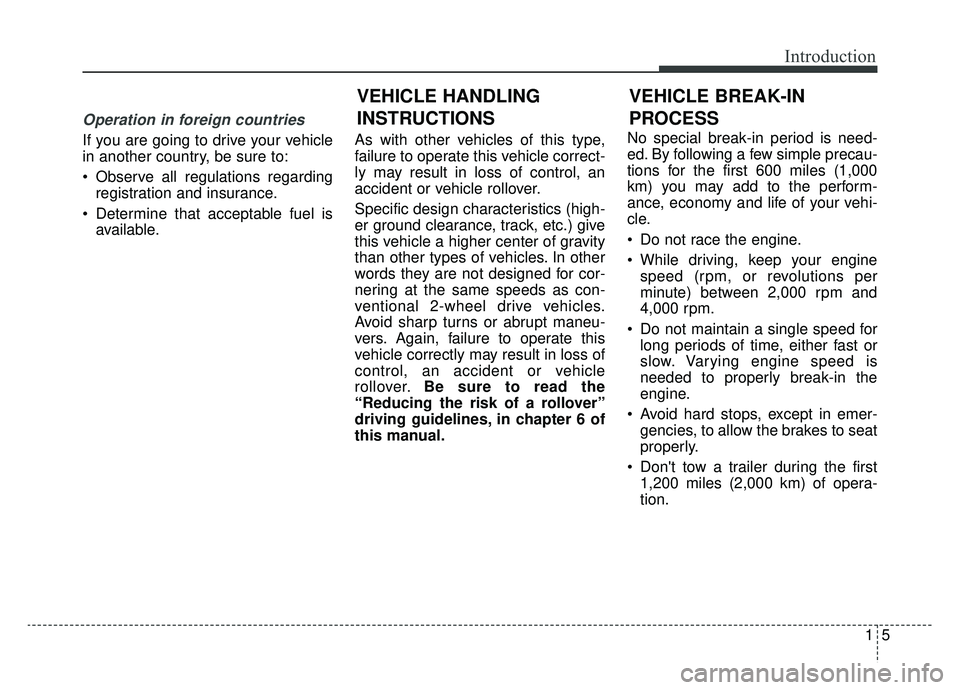
15
Introduction
Operation in foreign countries
If you are going to drive your vehicle
in another country, be sure to:
Observe all regulations regardingregistration and insurance.
Determine that acceptable fuel is available. As with other vehicles of this type,
failure to operate this vehicle correct-
ly may result in loss of control, an
accident or vehicle rollover.
Specific design characteristics (high-
er ground clearance, track, etc.) give
this vehicle a higher center of gravity
than other types of vehicles. In other
words they are not designed for cor-
nering at the same speeds as con-
ventional 2-wheel drive vehicles.
Avoid sharp turns or abrupt maneu-
vers. Again, failure to operate this
vehicle correctly may result in loss of
control, an accident or vehicle
rollover.
Be sure to read the
“Reducing the risk of a rollover”
driving guidelines, in chapter 6 of
this manual. No special break-in period is need-
ed. By following a few simple precau-
tions for the first 600 miles (1,000
km) you may add to the perform-
ance, economy and life of your vehi-
cle.
Do not race the engine.
While driving, keep your engine
speed (rpm, or revolutions per
minute) between 2,000 rpm and
4,000 rpm.
Do not maintain a single speed for long periods of time, either fast or
slow. Varying engine speed is
needed to properly break-in the
engine.
Avoid hard stops, except in emer- gencies, to allow the brakes to seat
properly.
Don't tow a trailer during the first 1,200 miles (2,000 km) of opera-
tion.
VEHICLE BREAK-IN
PROCESS
VEHICLE HANDLING
INSTRUCTIONS
Page 134 of 607
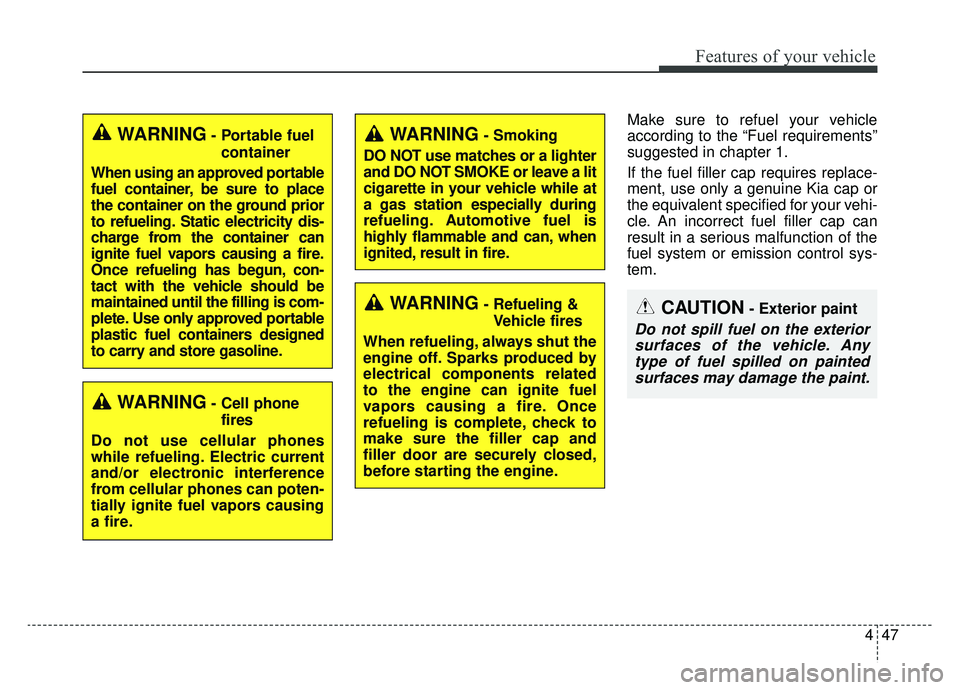
447
Features of your vehicle
Make sure to refuel your vehicle
according to the “Fuel requirements”
suggested in chapter 1.
If the fuel filler cap requires replace-
ment, use only a genuine Kia cap or
the equivalent specified for your vehi-
cle. An incorrect fuel filler cap can
result in a serious malfunction of the
fuel system or emission control sys-
tem.
WARNING- Cell phonefires
Do not use cellular phones
while refueling. Electric current
and/or electronic interference
from cellular phones can poten-
tially ignite fuel vapors causing
a fire.
WARNING- Smoking
DO NOT use matches or a lighter
and DO NOT SMOKE or leave a lit
cigarette in your vehicle while at
a gas station especially during
refueling. Automotive fuel is
highly flammable and can, when
ignited, result in fire.
WARNING- Refueling & Vehicle fires
When refueling, always shut the
engine off. Sparks produced by
electrical components related
to the engine can ignite fuel
vapors causing a fire. Once
refueling is complete, check to
make sure the filler cap and
filler door are securely closed,
before starting the engine.CAUTION- Exterior paint
Do not spill fuel on the exterior surfaces of the vehicle. Anytype of fuel spilled on paintedsurfaces may damage the paint.
WARNING- Portable fuel
container
When using an approved portable
fuel container, be sure to place
the container on the ground prior
to refueling. Static electricity dis-
charge from the container can
ignite fuel vapors causing a fire.
Once refueling has begun, con-
tact with the vehicle should be
maintained until the filling is com-
plete. Use only approved portable
plastic fuel containers designed
to carry and store gasoline.
Page 155 of 607
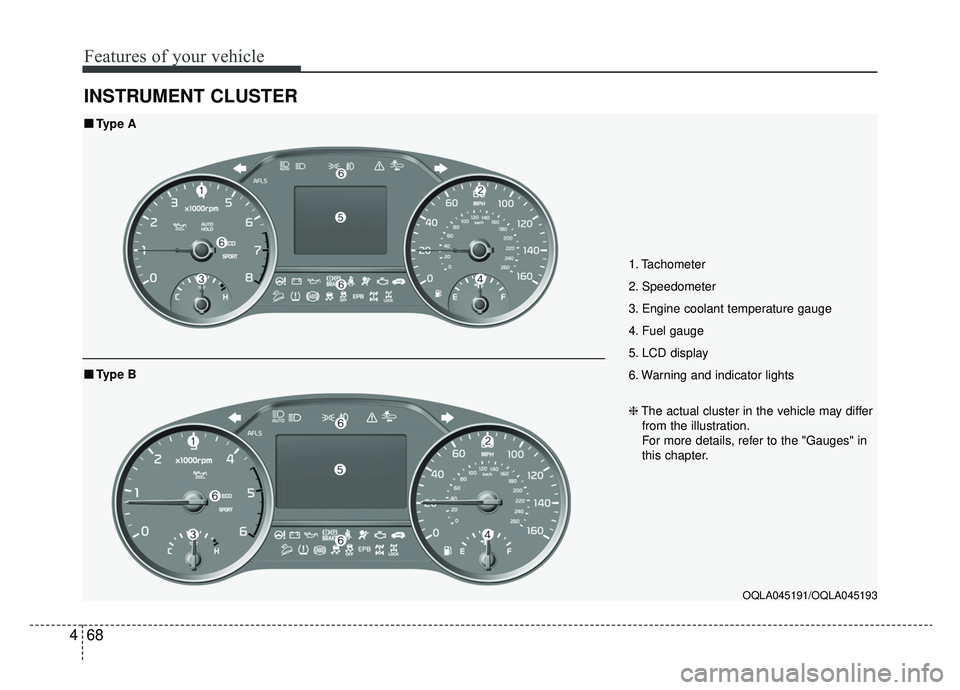
Features of your vehicle
68
4
INSTRUMENT CLUSTER
1. Tachometer
2. Speedometer
3. Engine coolant temperature gauge
4. Fuel gauge
5. LCD display
6. Warning and indicator lights
OQLA045191/OQLA045193
■ ■
Type A
❈The actual cluster in the vehicle may differ
from the illustration.
For more details, refer to the "Gauges" in
this chapter.
■ ■ Type B
Page 398 of 607
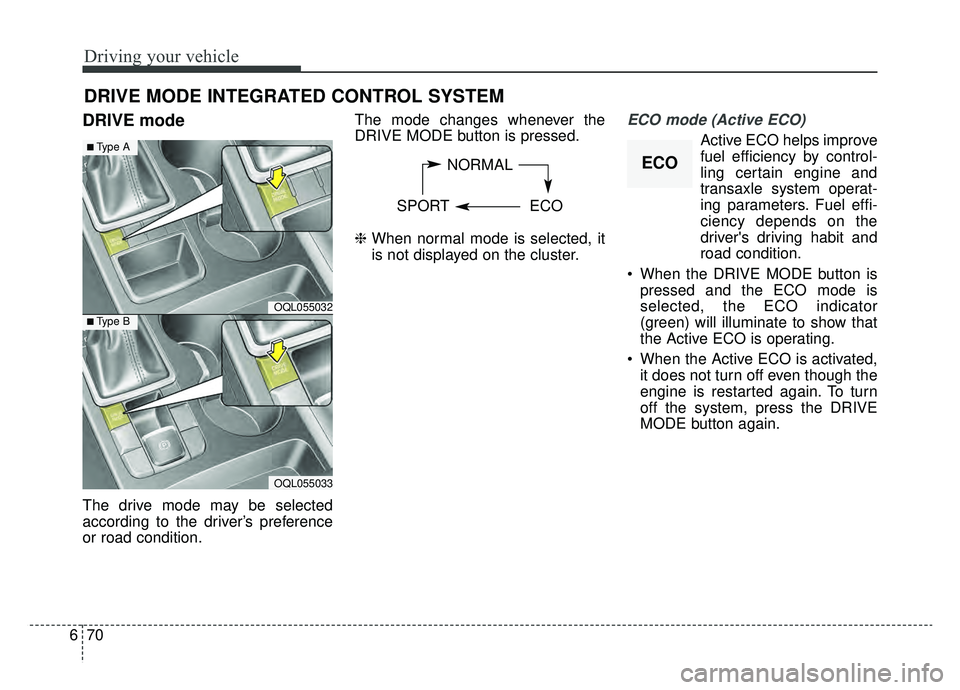
Driving your vehicle
70
6
DRIVE mode
The drive mode may be selected
according to the driver’s preference
or road condition. The mode changes whenever the
DRIVE MODE button is pressed.
❈
When normal mode is selected, it
is not displayed on the cluster.
ECO mode (Active ECO)
Active ECO helps improve
fuel efficiency by control-
ling certain engine and
transaxle system operat-
ing parameters. Fuel effi-
ciency depends on the
driver's driving habit and
road condition.
When the DRIVE MODE button is pressed and the ECO mode is
selected, the ECO indicator
(green) will illuminate to show that
the Active ECO is operating.
When the Active ECO is activated, it does not turn off even though the
engine is restarted again. To turn
off the system, press the DRIVE
MODE button again.
DRIVE MODE INTEGRATED CONTROL SYSTEM
NORMAL
SPORT ECO
OQL055032
■Type A
■Type B
OQL055033
ECO
Page 424 of 607
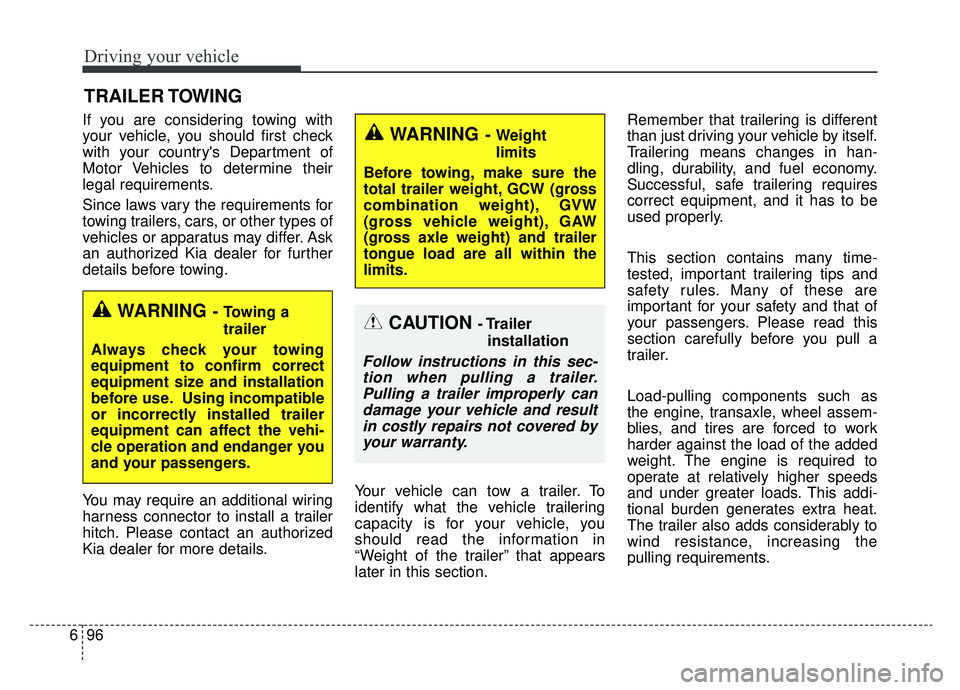
Driving your vehicle
96
6
If you are considering towing with
your vehicle, you should first check
with your country's Department of
Motor Vehicles to determine their
legal requirements.
Since laws vary the requirements for
towing trailers, cars, or other types of
vehicles or apparatus may differ. Ask
an authorized Kia dealer for further
details before towing.
You may require an additional wiring
harness connector to install a trailer
hitch. Please contact an authorized
Kia dealer for more details. Your vehicle can tow a trailer. To
identify what the vehicle trailering
capacity is for your vehicle, you
should read the information in
“Weight of the trailer” that appears
later in this section.Remember that trailering is different
than just driving your vehicle by itself.
Trailering means changes in han-
dling, durability, and fuel economy.
Successful, safe trailering requires
correct equipment, and it has to be
used properly.
This section contains many time-
tested, important trailering tips and
safety rules. Many of these are
important for your safety and that of
your passengers. Please read this
section carefully before you pull a
trailer.
Load-pulling components such as
the engine, transaxle, wheel assem-
blies, and tires are forced to work
harder against the load of the added
weight. The engine is required to
operate at relatively higher speeds
and under greater loads. This addi-
tional burden generates extra heat.
The trailer also adds considerably to
wind resistance, increasing the
pulling requirements.
TRAILER TOWING
CAUTION - Trailer
installation
Follow instructions in this sec-tion when pulling a trailer.Pulling a trailer improperly candamage your vehicle and resultin costly repairs not covered byyour warranty.
WARNING- Towing a
trailer
Always check your towing
equipment to confirm correct
equipment size and installation
before use. Using incompatible
or incorrectly installed trailer
equipment can affect the vehi-
cle operation and endanger you
and your passengers.
WARNING- Weight
limits
Before towing, make sure the
total trailer weight, GCW (gross
combination weight), GVW
(gross vehicle weight), GAW
(gross axle weight) and trailer
tongue load are all within the
limits.
Page 475 of 607

• Radial-ply tires . . . . . . . . . . . . . . . . . . . . . . . . . . . . . . 8-57
• Low aspect ratio tire . . . . . . . . . . . . . . . . . . . . . . . . . . 8-57
Fuses . . . . . . . . . . . . . . . . . . . . . . . . . . . . . . . . . . . . \
8-59
• Inner panel fuse replacement . . . . . . . . . . . . . . . . . . . 8-60
• Engine compartment fuse replacement. . . . . . . . . . . 8-62
• Fuse/relay panel description. . . . . . . . . . . . . . . . . . . . 8-65
Light bulbs . . . . . . . . . . . . . . . . . . . . . . . . . . . . . . . 8-77
• Bulb replacement precaution . . . . . . . . . . . . . . . . . . . 8-77
• Light bulb position (Front). . . . . . . . . . . . . . . . . . . . . 8-78
• Light bulb position (Rear) . . . . . . . . . . . . . . . . . . . . . 8-79
• Light bulb position (Side) . . . . . . . . . . . . . . . . . . . . . . 8-80
• Headlamp (HID type) bulb replacement . . . . . . . . . 8-80
• Headlamp (High/Low beam) bulb replacement . . . . 8-81
• Front turn signal lamp bulb replacement . . . . . . . . . 8-82
• Position lamp + DRL bulb replacement . . . . . . . . . . 8-83
• Front fog lamp (Bulb and LED type) bulbreplacement . . . . . . . . . . . . . . . . . . . . . . . . . . . . . . . . 8-83
• Stop and tail lamp bulb replacement . . . . . . . . . . . . 8-84
• Tail lamp (inside) bulb replacement . . . . . . . . . . . . . 8-85
• Stop and tail lamp (LED type) bulb replacement . . 8-86
• Back-up lamp and Rear turn signal lamp bulb replacement . . . . . . . . . . . . . . . . . . . . . . . . . . . . . . . . 8-86
• High mounted stop lamp bulb replacement . . . . . . . 8-87
• License plate lamp bulb Replacement. . . . . . . . . . . . 8-87
• Side repeater lamp (LED type) bulb replacement . . 8-88 • Map lamp bulb replacement . . . . . . . . . . . . . . . . . . . 8-88
• Vanity mirror lamp bulb replacement . . . . . . . . . . . 8-88
• Room lamp bulb replacement . . . . . . . . . . . . . . . . . . 8-89
• Personal lamp bulb replacement . . . . . . . . . . . . . . . . 8-90
• Glove box lamp bulb replacement . . . . . . . . . . . . . . . 8-90
• Tailgate room lamp bulb replacement . . . . . . . . . . . 8-91
Appearance care . . . . . . . . . . . . . . . . . . . . . . . . . . . 8-92
• Exterior care . . . . . . . . . . . . . . . . . . . . . . . . . . . . . . . . 8-92
• Interior care . . . . . . . . . . . . . . . . . . . . . . . . . . . . . . . . . 8-97
Emission control system . . . . . . . . . . . . . . . . . . . 8-100
• 1. Crankcase emission control system . . . . . . . . . . . 8-100
• 2. Evaporative emission control (including ORVR:
Onboard Refueling Vapor Recovery) system . . 8-100
• 3. Exhaust emission control system . . . . . . . . . . . . . 8-101
California Perchlorate notice . . . . . . . . . . . . . . . 8-103
8
Page 588 of 607
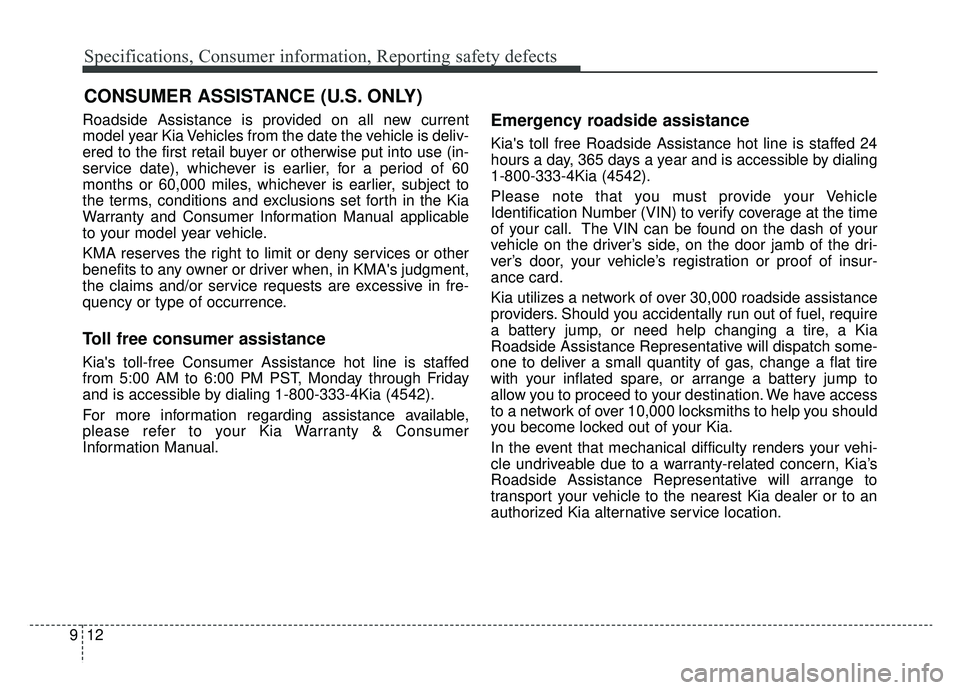
Specifications, Consumer information, Reporting safety defects
12
9
Roadside Assistance is provided on all new current
model year Kia Vehicles from the date the vehicle is deliv-
ered to the first retail buyer or otherwise put into use (in-
service date), whichever is earlier, for a period of 60
months or 60,000 miles, whichever is earlier, subject to
the terms, conditions and exclusions set forth in the Kia
Warranty and Consumer Information Manual applicable
to your model year vehicle.
KMA reserves the right to limit or deny services or other
benefits to any owner or driver when, in KMA's judgment,
the claims and/or service requests are excessive in fre-
quency or type of occurrence.
Toll free consumer assistance
Kia's toll-free Consumer Assistance hot line is staffed
from 5:00 AM to 6:00 PM PST, Monday through Friday
and is accessible by dialing 1-800-333-4Kia (4542).
For more information regarding assistance available,
please refer to your Kia Warranty & Consumer
Information Manual.
Emergency roadside assistance
Kia's toll free Roadside Assistance hot line is staffed 24
hours a day, 365 days a year and is accessible by dialing
1-800-333-4Kia (4542).
Please note that you must provide your Vehicle
Identification Number (VIN) to verify coverage at the time
of your call. The VIN can be found on the dash of your
vehicle on the driver’s side, on the door jamb of the dri-
ver’s door, your vehicle’s registration or proof of insur-
ance card.
Kia utilizes a network of over 30,000 roadside assistance
providers. Should you accidentally run out of fuel, require
a battery jump, or need help changing a tire, a Kia
Roadside Assistance Representative will dispatch some-
one to deliver a small quantity of gas, change a flat tire
with your inflated spare, or arrange a battery jump to
allow you to proceed to your destination. We have access
to a network of over 10,000 locksmiths to help you should
you become locked out of your Kia.
In the event that mechanical difficulty renders your vehi-
cle undriveable due to a warranty-related concern, Kia’s
Roadside Assistance Representative will arrange to
transport your vehicle to the nearest Kia dealer or to an
authorized Kia alternative service location.
CONSUMER ASSISTANCE (U.S. ONLY)
Page 599 of 607
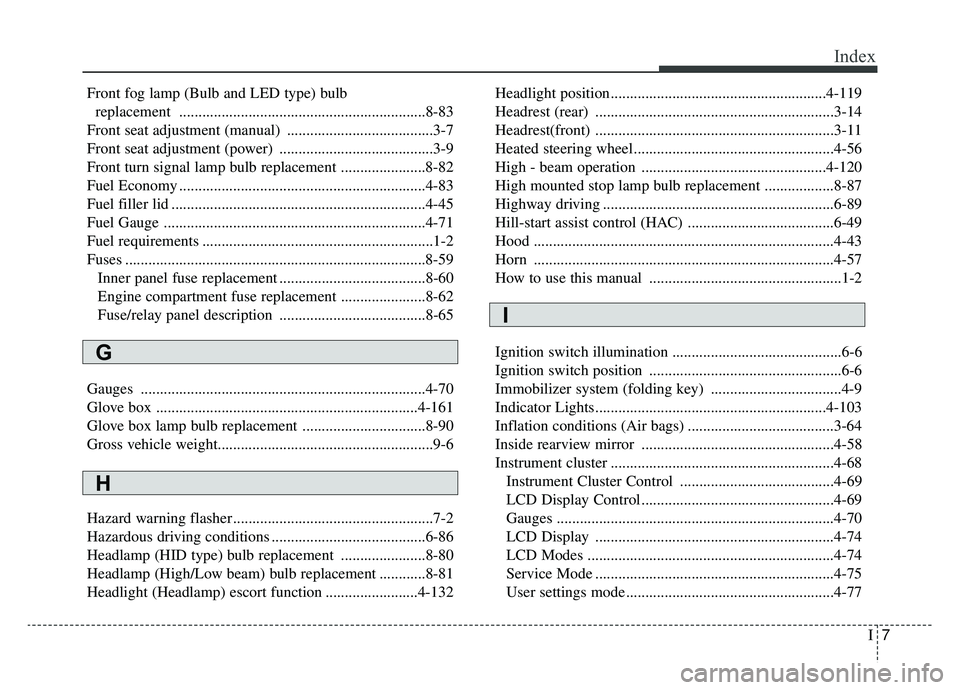
I7
Index
Front fog lamp (Bulb and LED type) bulbreplacement ............................................................\
....8-83
Front seat adjustment (manual) ......................................3-7
Front seat adjustment (power) ........................................3-9
Front turn signal lamp bulb replacement ......................8-82
Fuel Economy ................................................................4-83
Fuel filler lid ..................................................................4-45
Fuel Gauge ....................................................................4-71\
Fuel requirements ............................................................1-2
Fuses ........................................................................\
......8-59 Inner panel fuse replacement ......................................8-60
Engine compartment fuse replacement ......................8-62
Fuse/relay panel description ......................................8-65
Gauges ........................................................................\
..4-70
Glove box ....................................................................4-16\
1
Glove box lamp bulb replacement ................................8-90
Gross vehicle weight........................................................9-6\
Hazard warning flasher ....................................................7-2
Hazardous driving conditions ........................................6-86
Headlamp (HID type) bulb replacement ......................8-80
Headlamp (High/Low beam) bulb replacement ............8-81
Headlight (Headlamp) escort function ........................4-132 Headlight position........................................................4-119
Headrest (rear) ..............................................................3-14
Headrest(front) ..............................................................3-11
Heated steering wheel....................................................4-56
High - beam operation ................................................4-120
High mounted stop lamp bulb replacement ..................8-87
Highway driving ............................................................6-89
Hill-start assist control (HAC) ......................................6-49
Hood ........................................................................\
......4-43
Horn ........................................................................\
......4-57
How to use this manual ..................................................1-2
Ignition switch illumination ............................................6-6
Ignition switch position ..................................................6-6
Immobilizer system (folding key) ..................................4-9
Indicator Lights............................................................4-103
Inflation conditions (Air bags) ......................................3-64
Inside rearview mirror ..................................................4-58
Instrument cluster ..........................................................4-68
Instrument Cluster Control ........................................4-69
LCD Display Control ..................................................4-69
Gauges ........................................................................\
4-70
LCD Display ..............................................................4-74
LCD Modes ................................................................4-74
Service Mode ..............................................................4-75
User settings mode ......................................................4-77
H
G
I